When it comes to getting a dog the most important thing besides the dog’s energy level is the dog’s size. Not every dog breed is meant to be a perfect fit for everybody. Some people like big dogs while others prefer medium-sized or big doggies.
It is very important to know that even if you love bigger dogs but do not have the space to keep them, it is best to get a smaller dog.
Since you are reading this article, we can tell that you have narrowed down your choice of dog and that you are doing thorough research on the breed. For that we applaud you.
Siberian Huskies are beautiful dogs, but they can be quite tricky to own for many reasons. But if you have done all the needed research, we are sure that you can handle all of that and be good at doing it.
That is enough chit-chat. We need to see how big these pooches get and we will do so by making a Husky growth chart.
More About This Gorgeous Breed
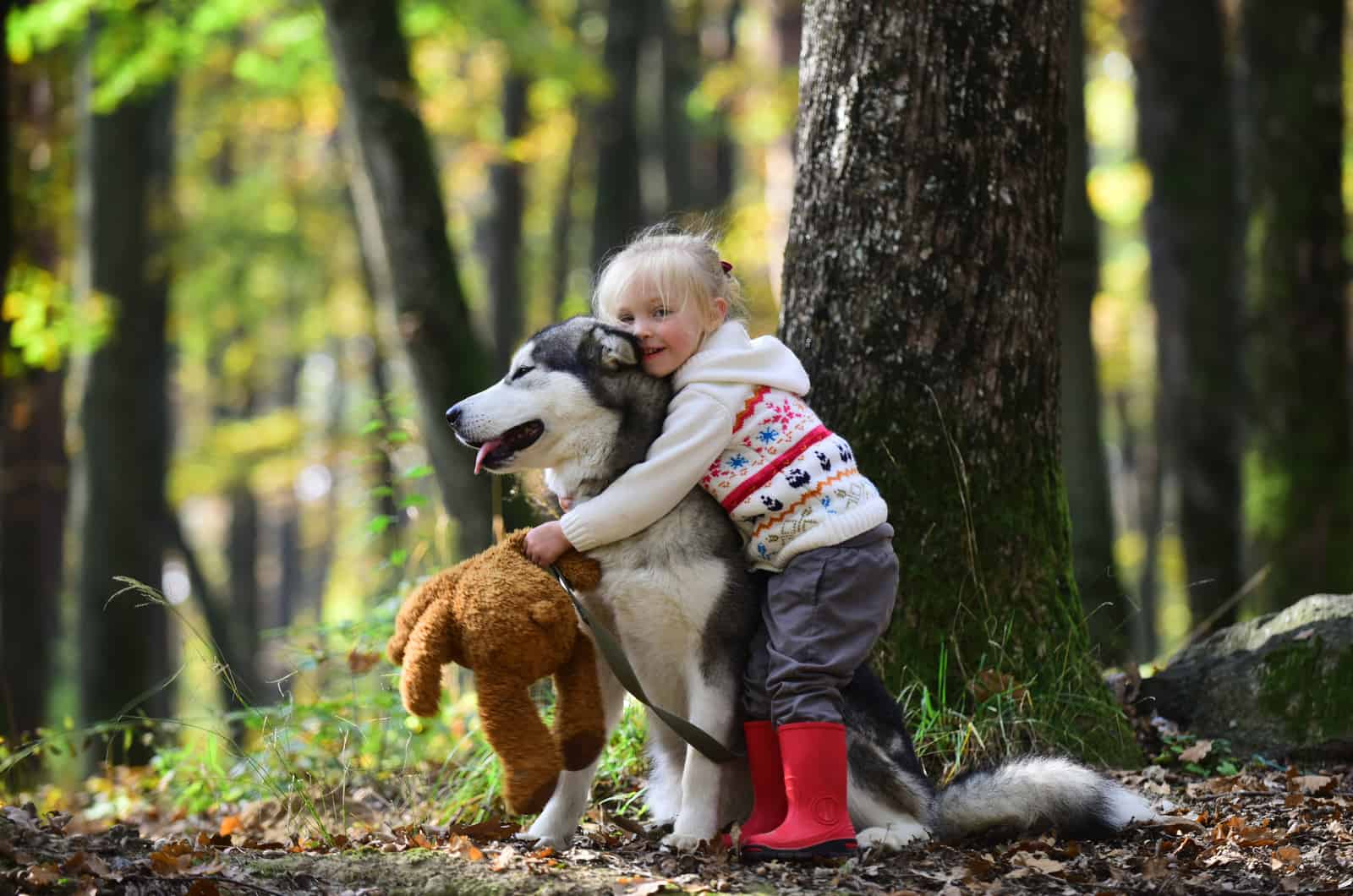
Huskies are a well-known breed across the whole world. They have been included in many movies and cartoons. A Husky is the first breed that I remember. These beautiful dogs have long and thick coats that protect them from the cold.
They can come in different colors and we cannot decide which one we like the best. You need to be prepared that these pooches shed a lot. Your best friends will be a brush and a vacuum cleaner, especially during the shedding season.
Siberian Huskies are amazing with other dogs and kids. They are not aggressive at all but only if you have done the socialization process correctly.
These dogs are working dogs and they need to be constantly on the move. These dogs are energetic and need a lot of space. A house with a big yard is something that is ideal for them.
They are mostly known as sled dogs. There are many movies that showcase these brave and amazing pooches as sled dogs.
They can be a bit too much for people that have never owned a dog before, but since they are really intelligent and eager to please their owner, you will be able to calm down their wild side a bit.
Male Husky Growth Chart
When you want to know how big a certain breed gets, people usually tend to look at the male height and weight of that certain breed. There are some differences between male and female Huskies, but the difference is not that big.
Here is a chart that is two in one, which means that we put a Siberian Husky height chart and Siberian Husky weight chart in one big chart, so it is clearer see how big these pooches get.
This can be considered the Husky puppy weight chart and Husky puppy height chart. At the end of the chart, you will be able to see the average weight and height of an adult Husky.
| Age | Male Weight | Male Height |
|---|---|---|
| 2 months | 10-15 lbs | 10-12 inches |
| 3 months | 18-23 lbs | 10-12 inches |
| 4 months | 22-30 lbs | 12-15 inches |
| 5 months | 25-35 lbs | 12-15 inches |
| 6 months | 30-40 lbs | 15-19 inches |
| 7 months | 33-43 lbs | 15-19 inches |
| 8 months | 35-47 lbs | 19-22 inches |
| 9 months | 39-52 lbs | 19-22 inches |
| 10 months | 40-55 lbs | 22-24 inches |
| 11 months | 40-58 lbs | 22-24 inches |
| 1 year | 43-57 lbs | 22-24 inches |
| 2 years | 45-60 lbs | 22-24 inches |
This is approximately how your Siberian Husky should grow. Weight and height can depend on different things so if your dog is a bit lighter and smaller than this, or even bigger and a bit heavier it is fine.
But try to be as close to this number as possible because it can cause some different problems like obesity or being underweight.
Female Husky Growth Chart
Just like with the male Siberian Husky growth chart, you will have a weight chart and height chart in one big chart. You will be able to notice that the female Huskies will be a bit smaller and lighter than the male Husky.
When it comes to weight the difference usually comes from the fact that male Siberian Huskies will have more muscles and appear to be a bit stronger than female Huskies.
But of course, this is not always the case.
Here is the female Husky growth chart.
| Age | Female Weight | Female Height |
|---|---|---|
| 2 months | 8-12 lbs | 10-12 inches |
| 3 months | 13-20 lbs | 10-12 inches |
| 4 months | 18-25 lbs | 12-14 inches |
| 5 months | 21-31 lbs | 12-14 inches |
| 6 months | 23-33 lbs | 14-16 inches |
| 7 months | 25-38 lbs | 14-16 inches |
| 8 months | 28-42 lbs | 16-18 inches |
| 9 months | 31-46 lbs | 16-18 inches |
| 10 months | 32-47 lbs | 18-20 inches |
| 11 months | 33-48 lbs | 18-20 inches |
| 1 year | 34-49 lbs | 20-22 inches |
| 2 years | 35-50 lbs | 20-22 inches |
Females can also be a bit bigger or smaller than these measurements, but they should not be far from these height and weight ranges. This is the same thing we mentioned with the male Siberian Huskies.
If you think that your pooch is too small or big you can always go to the vet and check with them that everything is alright.
You need to know that some dogs, within the same breed, grow faster while others can grow a bit slower. This can be the reason why your, for example, puppy of 6 months of age, is smaller than another female at the same age.
But when they come to the 2-year mark, they should be their adult size and should be somewhere within the numbers that are presented in this chart.
Husky Growth Stages
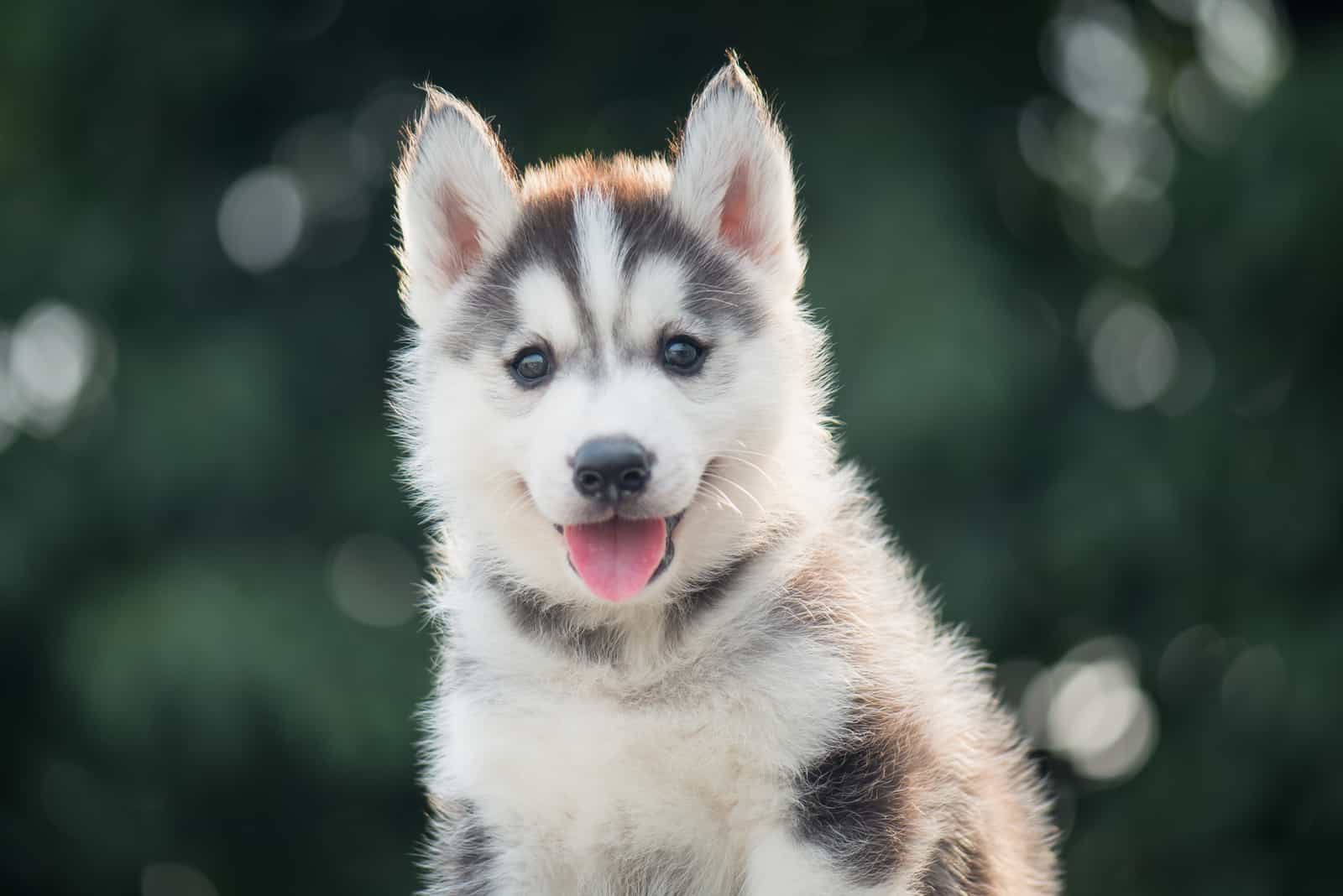
Every dog breed has a pace at which they grow. Usually, the bigger breeds have a period of their development where they tend to grow quite a lot. The Siberian Husky is considered to be a medium-sized dog and you might be shocked at how fast they grow.
The puppy growth will pass at the speed of light because there are many interesting things that are happening in that period.
We will go through some of the growth stages and what can you expect from each stage as well as what you need to do and keep an eye on.
From Birth To 2 Weeks Old – Neonatal Period
This is the period when every Siberian Husky puppy is the most fragile. They depend on their mother the most. In this period the puppies are both blind and deaf. They rely on their senses to find the mother’s breast and to cuddle up with their siblings.
After 10 days of their lives, the eyes will slowly start to open. You will notice it, but you need to know that they are not able to see that well.
After the first 2 weeks of their lives is the period when they start to grow rapidly. This is usually the period that you will not be able to see because the puppies will still be with the breeder and their mother.
Puppies will significantly grow until they come to you when they are 8 weeks old. But don’t worry, you did not miss a lot. A lot of interesting things will happen as they arrive at your home.
Why Is The Mother So Important For The Puppies At This Stage?
The mother is crucial in this period of growth. The main reason is her milk. This is the best option when it comes to food for puppies this small. The milk is full of nutrients that can hardly be replaced by any store-bought food that is intended for puppies.
They are keeping the puppies warm as well. She has the natural instinct to feel if something is potentially wrong with the puppy. We as people cannot notice some of those things but she will for sure.
She is helping them pee and poop as well by licking their private parts. This is in the first days of their lives. She is also keeping them clean which is important because puppies that small cannot be bathed.
There are some examples where the puppies are separated from their mother in this stage, mostly it is a tragic event, and they end up growing normally and being healthy. But you need to know that a lot of the pooches don’t make it without their mother.
No reputable breeder will give their dogs away at this stage, so if you see a person selling a puppy this young you should avoid them and find someone who is reliable and has a lot of knowledge about the needs of puppies.
From 2 Weeks To 3 Weeks Old – Transitional Stage
This is a stage where the pups are very interesting to observe. A lot of things will be happening in the span of a week. This is something that you probably will not experience but you can always ask your breeder to fill you in on the progress of the puppy.
Their eyesight improves drastically. Since Huskies are especially curious, their eyesight development will give them the courage to explore their surroundings.
Don’t worry they probably won’t go too far because their tiny legs get tired easily. The mother is there as well to keep an eye on them, and she never lets them go too far from her.
Their hearing is also getting better at this point as well. Reacting to your voice and other sounds from the environment is very cute to observe.
They will mostly appear to be a bit confused but some of the brave ones will try to protect their other siblings.
You will be able to see their baby teeth slowly appearing. You can introduce them to wet food, but it is not the best thing to do. Their mother’s milk should be their main food resource.
But the cutest thing that this stage brings is puppies playing with each other and showing some emotions. An occasional tail wag and a growl here and there will be quite noticeable.
From 3 Weeks To 13 Weeks Old – Socialization Period
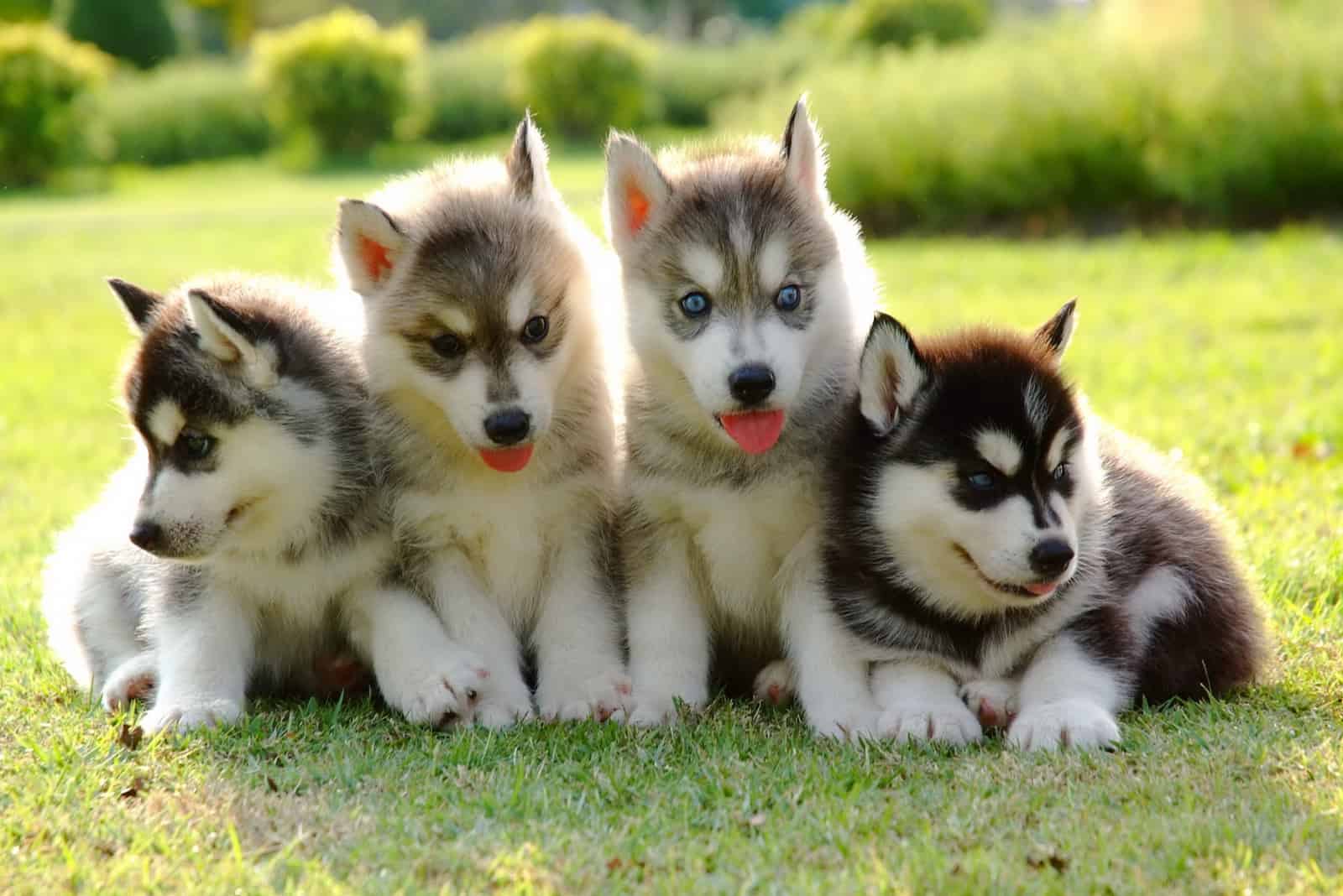
The most exciting thing at this stage is that you get to bring your puppy home! As soon as they turn 8 weeks old you will take your dog to their forever home.
At this point, you will be able to notice the high energy levels of this breed. They will start to bark and even howl, chew on everything and anything, chase other dogs and anything that they find interesting, etc.
In the first couple of weeks of this growth period, your puppy will be more than able to be separated from its mother. This means that they will start eating store-bought puppy food and that they have gained enough energy and grown enough to be able to survive on their own.
The good thing is that you will be able to experience many of these things yourself. What you need to know is that you are the key factor in this stage of their life.
You will need to start the socialization process and start training your puppy. Both of these are crucial for the future of your dog.
If you do not socialize your dog, you can end up with an aggressive and even anxious dog. You need to introduce them to as many sounds, environments, dogs, animals, kids, and people as possible.
At 6 weeks old your puppy will get their first vaccine which is provided by the breeder. You need to make sure that the other necessary vaccines are given at the right time and that you listen to your vet as to when they are due.
At this point, the females will weigh around 8 to 12 pounds and grow to be 10 to 12 inches, while the males will weigh around 10 to 15 pounds and be the same height as the female Husky.
RELATED: How To Socialize An Aggressive Dog: A Simple Guide For Dog Owners
Why Is Socialization Important?
We already mentioned that dogs that do not get the proper socialization can get aggressive and anxious. This can cause a lot of problems for both the dog and the owner.
You will not be able to enjoy simple things like taking your dog for a walk or letting them play in the dog park.
This can be extremely overwhelming for pet parents. This will for sure deteriorate the quality of your dog’s life because you probably won’t let them play with other dogs, which is more than understandable, and that can take a toll on your pooch.
This is extremely important for Huskies because they are naturally friendly dogs that love to play. It is almost in their DNA to play with other dogs and people.
Introducing them to many different sounds, people, kids, and animals is important. You want your dog to get used to many different things, so they do not turn out to be dogs that are scared of everything.
Having a friendly dog that is able to enjoy every situation you put them in is truly amazing. For example, I never took my dog to the beach until he was 2 years old. It was extremely difficult to make him relax.
It took some time for him to get into the sea, but after a long time, he realized that this was a positive experience and he liked it a lot. But if I introduced him to the beach sooner, he would have been relaxed, and enjoying the experience would have come much sooner.
At 12 weeks old they will grow to be 10 to 12 inches. The females will weigh 13-20 pounds while the males will weigh 18-23 pounds.
From 13 Weeks To 6 Months Old – Juvenile Period
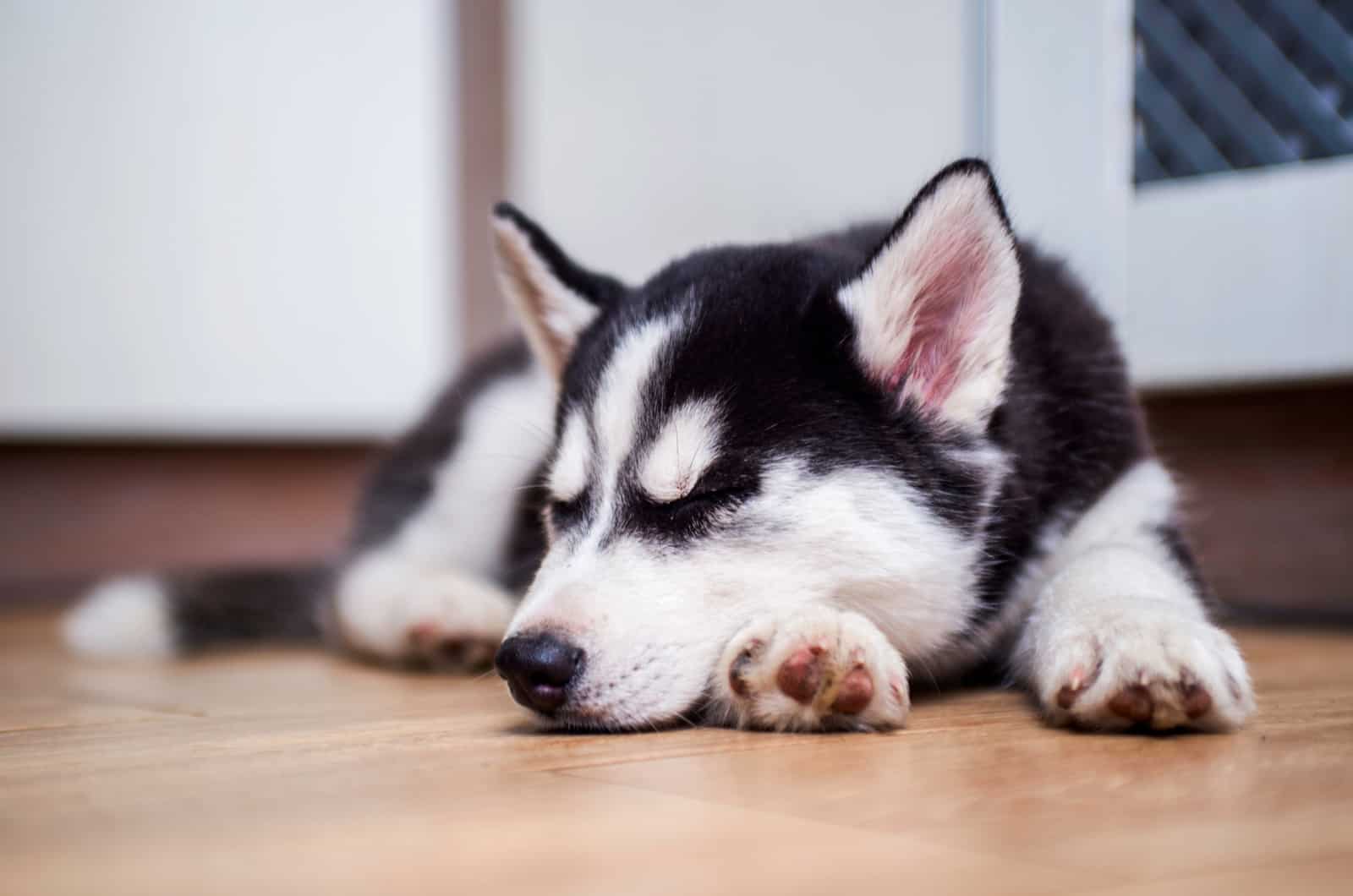
This is the dog’s teenage stage of life as we like to call it. They become little delinquents and will most definitely test their boundaries. In this period your dog has gone through some socialization processes that need to continue.
Now you need to start with the new phase, which is showing them who is the pack leader. If you do not set some boundaries with your dog in this phase of life, it will be much more difficult to set them up later on.
When a Husky gets to around 6-month-old, females will get their first period while the males will showcase a lot of interest towards the females, or in other words, they will get more sexually mature.
Some of the males will start to raise their hind legs when they pee. This is not the case with every male. Some will start raising the hind leg when they turn one year old. This varies from dog to dog so do not get concerned.
The dogs will slowly transition into their adult weight which is around 23-33 pounds for the females and 30-40 pounds for the male Huskies, and their average height will be around 14 to 19 inches.
RELATED: Why Do Dogs Like Period Blood? 6 Reasons And 3 Solutions
From 6 Months To 18 Months Old – Adolescence Period
In this period your dog should have gotten all the needed vaccines that will protect it from various diseases. Your Husky pup is really close to becoming an adult. The dog’s weight will be around 34-49 pounds for females and 43-57 pounds for males.
The average height will be around 20 to 24 inches.
Males will be at the peak of their sexual maturity. At this point, you will probably spay or neuter your dog if you do not want them to produce any puppies.
Their energy levels will be at their peak as well. You probably thought that they cannot get any more energetic, but you are in for a treat.
But the good thing is that they will need a lot of playtime that will for sure fulfill their energy needs. This is also amazing for creating a bond between the owner and the pooch.
They will need some one-on-one playtime with you, but make sure to take them out so they can play with other dogs as well. This can be considered the final stage of the socialization process. Combining the two types of playtime will give your dog the perfect balance.
RELATED: When To Take Cone Off Dog After Neuter And 4 Cone Alternatives
Adulthood
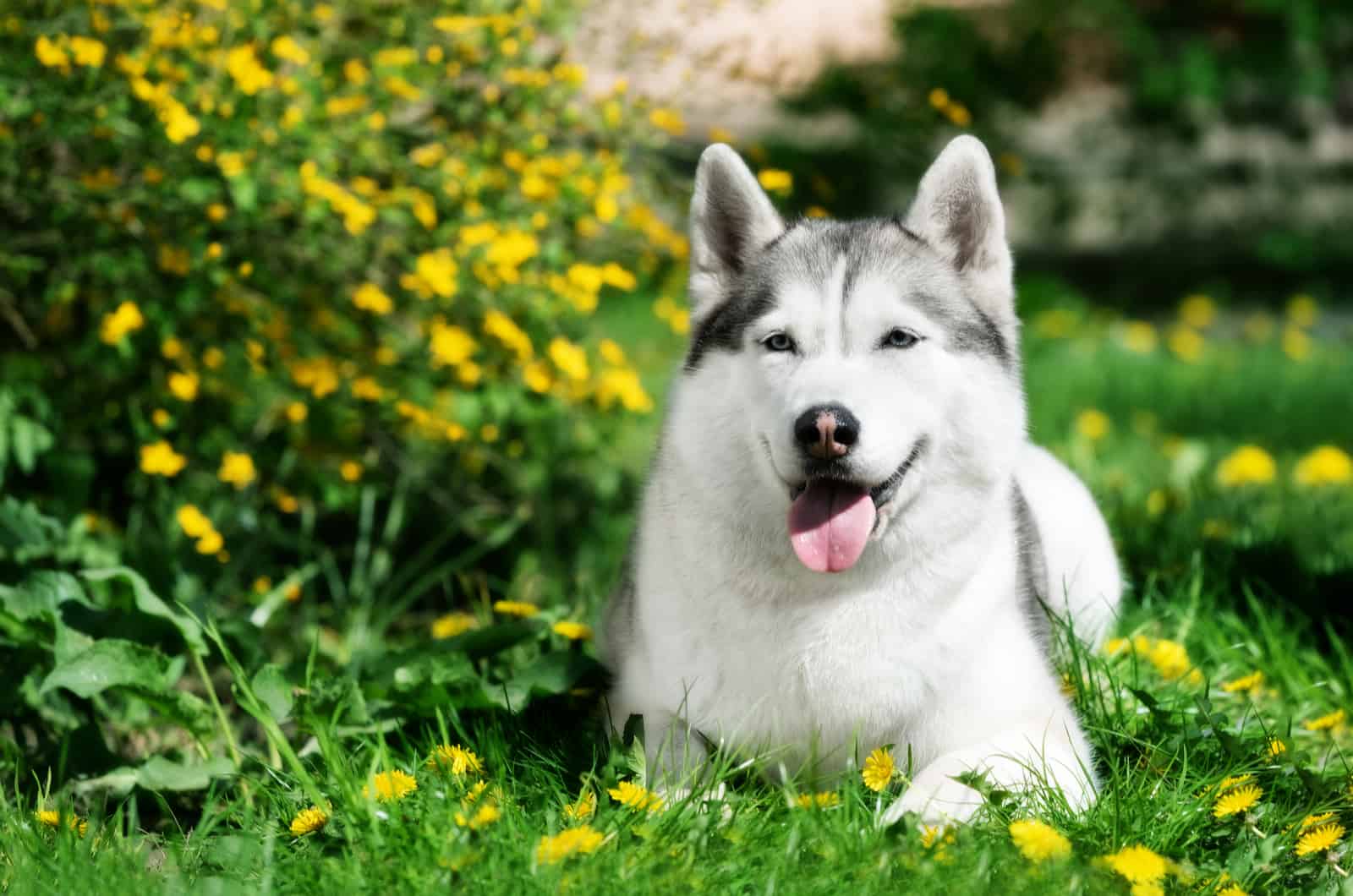
Time flies when you are having fun and getting to experience many interesting things with your beloved puppy. Your dog has reached their potential when it comes to size, but there might be some more space for them to improve mentally and get more mature.
The maturity period varies from dog to dog. Huskies can mature in the span of 1 to 3 years of age. This is more about genetics and what type of behavior they have inherited from their parents.
After all the changes that you and your pooch went through, this is the time you get to enjoy their full potential. Enjoy every moment with your dog and make sure to give them a lot of love and attention.
This is the period where all the memories with your furry best friend will be created.
When Will My Husky Stop Growing?
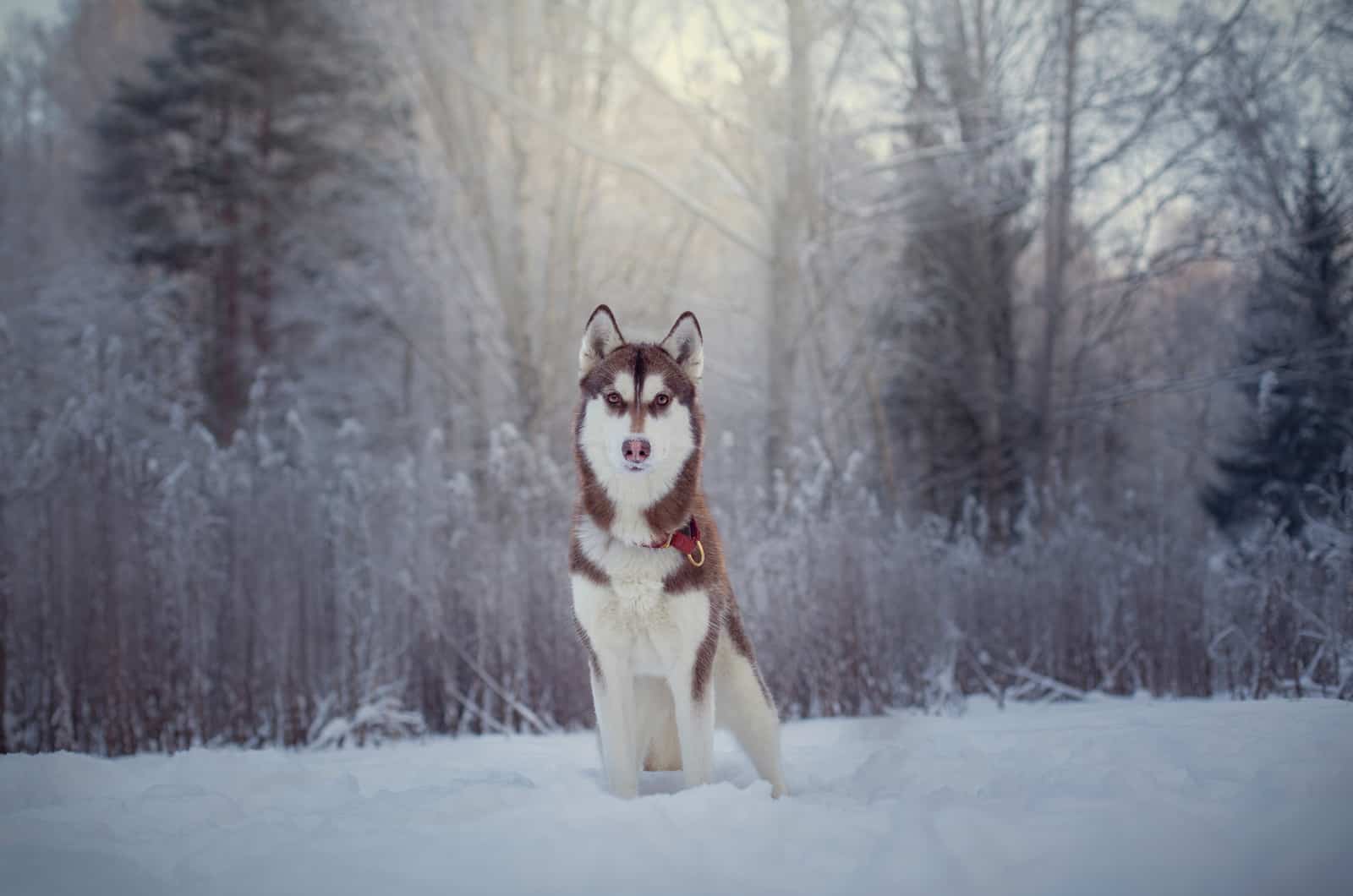
Around 18 months of age is when they are considered to be adults, and this is usually the time when they stop growing. They will reach their full height. When it comes to weight you can never really say that they have reached their full weight in the same way as with height.
This depends on you and how you treat your dog. What does this mean? Well, there are a couple of factors like proper nutrition and how much exercise your dog has daily.
They can always lose and gain some weight but try to keep them within the range that you can see on the chart which is at the beginning of this article.
Some Huskies might grow for a bit longer than the 18-month-mark. When it comes to females, they are considered to have stopped growing when they turn 15 months old.
What About Mental Growth?
Physical growth is not the only one that dogs need to go through. Sometimes we forget that dogs need to mentally mature just like us people. This might be a bit less noticeable with dogs.
This does not mean that your dogs, for example, energy levels will lower or that they will go through some epiphany. This just means they will go from a puppy brain to an adult dog brain, meaning that they will become a bit more of an elevated version of themselves at some point.
When it comes to Huskies, they will reach their maturity when they are 3 years old. Some might reach it sooner, but the average is when they turn 3 years old. But when they turn 18 months old that is the dog that you will have for the rest of your life, just with some small differences in behavior.
Factors That Can Affect The Growth Of Your Husky
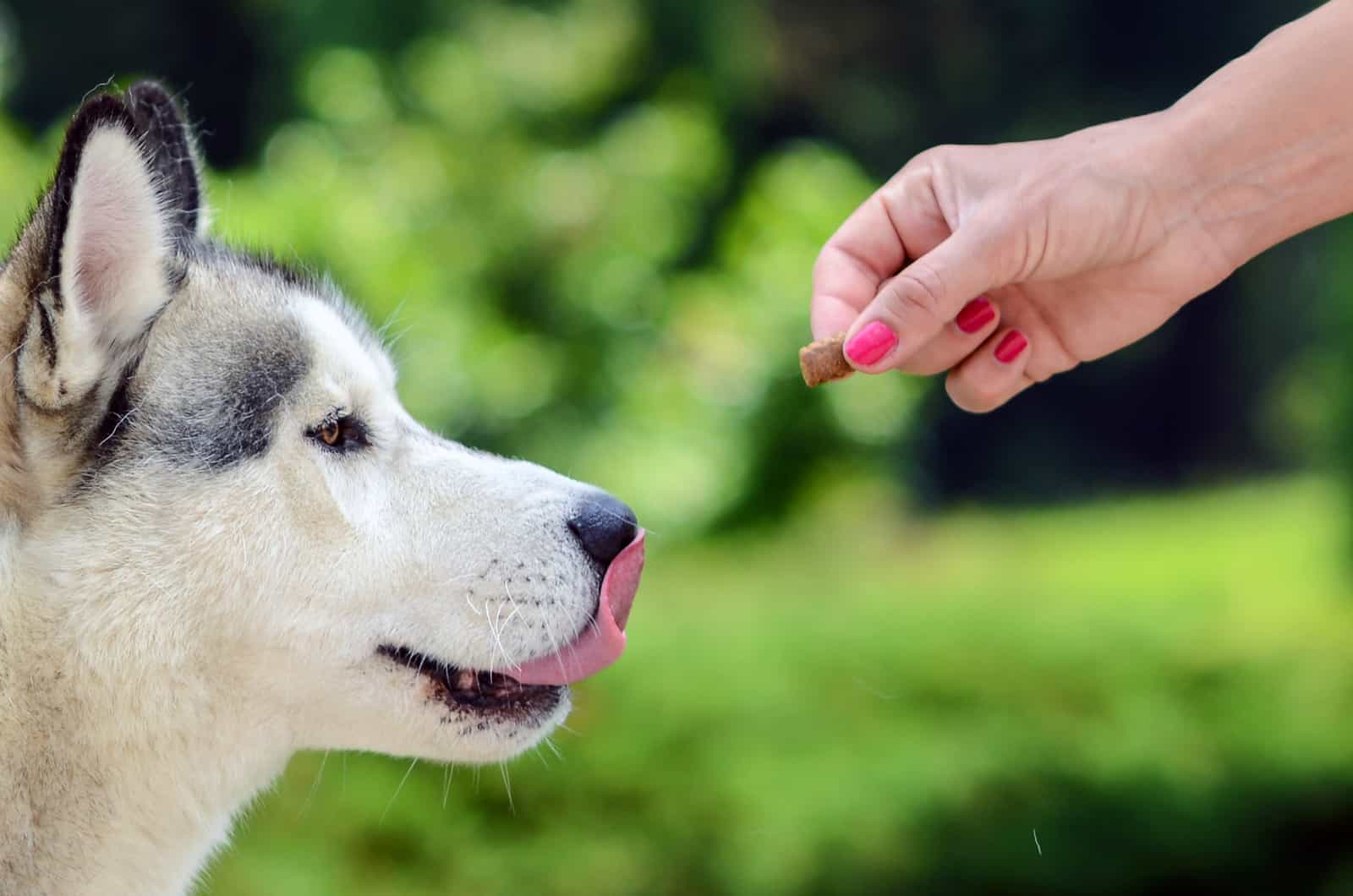
Every dog within the same dog breed is not exactly the same. This includes their temper and size. Yes, there is a growth chart for every dog breed, including this one as we saw earlier, but not every dog will fit the bracket perfectly.
There are some factors that play a role in the size of the dog. Some are more known than others. This does not mean anything bad, or that every single factor is negative by any means.
Some are out of our hands while other factors are determined by us as dog owners. We wanted to make sure to know them in case your dog is not the size you thought it would be.
Here are some of the factors that can affect the growth of your pooch.
1. Genetics And Gender
This is the most logical and obvious factor. Every breed has a standard size, some even have a couple of them, like for example a Poodle. These dogs can come in three different sizes and within every size, there is a chart that can show you how big they truly get.
When it comes to Huskies, they were originally only in one size as presented in this article, but there is also a miniature Husky. Some people don’t consider them real Huskies and they are fairly new so we will be focusing only on the bigger ones.
As we already saw, female Huskies will be a bit smaller than the males, but there can also be differences between the males. Some might be bigger because they have stronger build.
This is why you can see how big your dog may be, by looking at its parents. If both of the parents are on the bigger side your pooch is most likely to be bigger as well, and the other way around.
Both of these factors do not affect the dog negatively by any means. This is something natural and you don’t have to worry about it. There is nothing you can do when it comes to this other than pick the preferable size.
If you want your Husky to be on the smaller, more petite side you can choose a breeder that has smaller breeding dogs.
2. Proper Nutrition
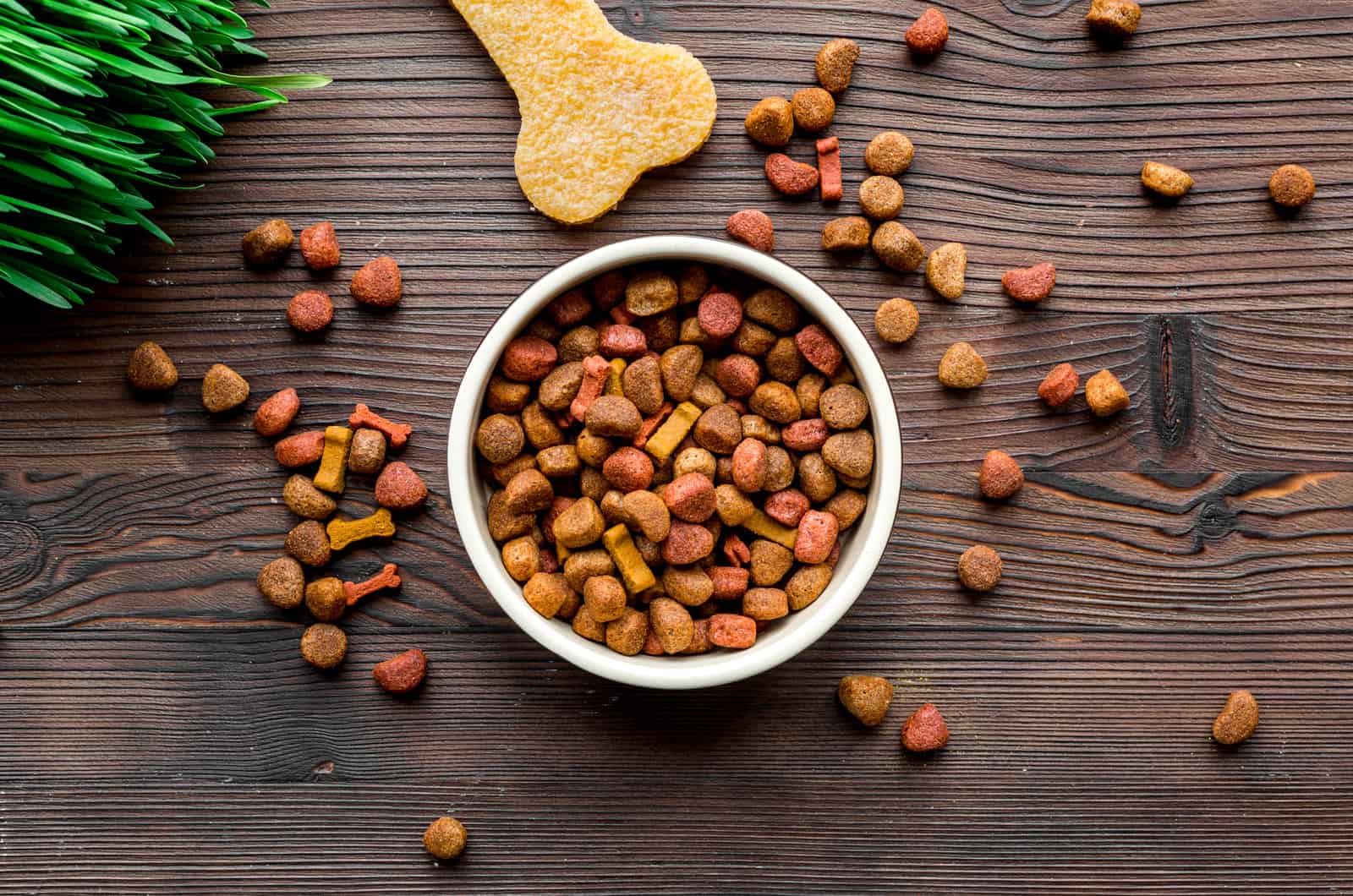
Dog nutrition is very important when it comes to the size of the dog. From the moment when they are born until they get to the one-year mark, nutrition is extremely important for every type of dog, small dogs, medium-sized dogs, and large dogs.
At the beginning stages of their lives, dogs depend on the milk of their mother. This is the best type of food that they need when they are in the most fragile stage of their lives.
There can be substitutes for mother’s milk, but they will never be as good as natural milk.
Once they get off the milk, this is where you step in. It is very important to find the best dog food for your puppy and after that for your adult dog. Puppy dog food will have more calories and nutrients that are needed for the proper growth of your dog.
Adult dog food will have different nutrients that are needed for a grown dog. There are a couple of varieties from which you can choose to give to your adult dog. Home-cooked, raw food, or store-bought food are all options.
Whatever you choose, make sure that they receive everything that they need to stay energized and healthy.
If the nutrition is not good during their growing phase, they might not be the expected size. This can affect both height and weight and can cause some serious health issues.
If you give your dog too much food it can become obese, and if you give your dog not enough food it can become malnourished. Both of these are extremely bad for the dog and can cause various health problems so try to do enough research, so you know what the proper amount of food that you need to give your dog is.
The malnourished dogs can have more serious problems than the dogs that are obese, but both are dangerous.
An adult male will need a bit more food during the day than a female Husky. If you are not sure what food is the best, how much to give your dog, and how often, you can always contact the vet for some advice and you can even ask the breeder for some recommendations when you pick your puppy up.
3. Sleep
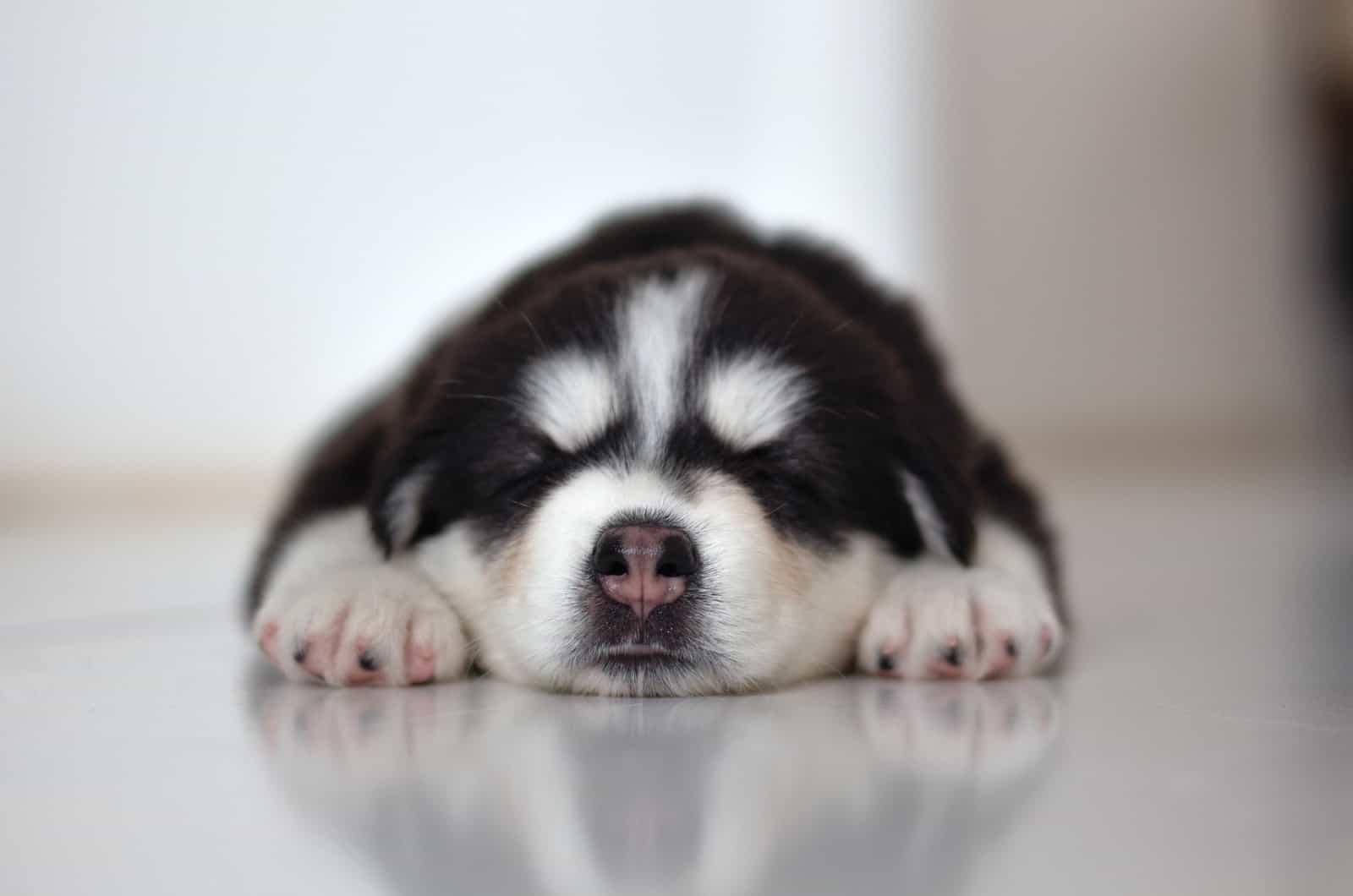
Sleeping is very important for dogs, especially puppies, but some people didn’t know that it can affect the growth of the dog. Puppies are known to love to sleep. Sleeping is essential for them, not only because they love it but because it benefits them.
Puppies love to play and explore, and they need a lot of energy to do so. They get tired easily and this is where sleeping comes in. If they do not sleep enough, they will not have the energy to proceed with their day normally.
Sleep is also important for an old Husky, but it does not affect its growth, obviously.
When we say that sleep affects their growth, we do not mean that they grow as they sleep so if they do not sleep enough that they will not grow enough. No no.
This means that firstly, and as already mentioned, they will not have the energy to concur the day in their full energized way. This can cause your dog to become chubby and that can cause joint problems which can also cause some difficulties when it comes to their height.
Secondly, since they do not play without any energy their immune system can get seriously compromised. This leads to your dog getting sick often.
Sick dogs will not go through all the growth phases as a healthy dog would, and this means that they probably won’t have a healthy weight and height.
Getting a new puppy is extremely interesting and exciting. We all want to play with our puppies all the time, but you need to make sure to give them enough time to rest. You can always spend some time with your puppy by cuddling up near them and taking a quick nap together.
4. Regular Vet Visits
Regular vet visits are a must when it comes to puppies. The main reason is their regular vaccines. Vaccines are important for your dog’s immune system to learn how to fight off some severe illnesses.
If your doggy does not get all the necessary vaccines, it can get extremely sick. This can take a toll on the dog’s growth process.
Regular vet visits are not only important for vaccines. If your dog is regularly checked by the vet you can find something that pooches are extremely prone to, and those are different types of parasites.
These pests can affect the dog in many different ways which can cause some problems in their growth process. Doggies that end up getting these parasites will most likely have some stomach problems.
A sick puppy will unfortunately not eat enough and will not get all the needed nutrients that every puppy needs to get. This will slow down their growth.
If you bring your puppy to get checked often the vet will be able to catch these parasites on time and start the treatment on time so it does not affect your pooch badly.
5. Exercise And Playing
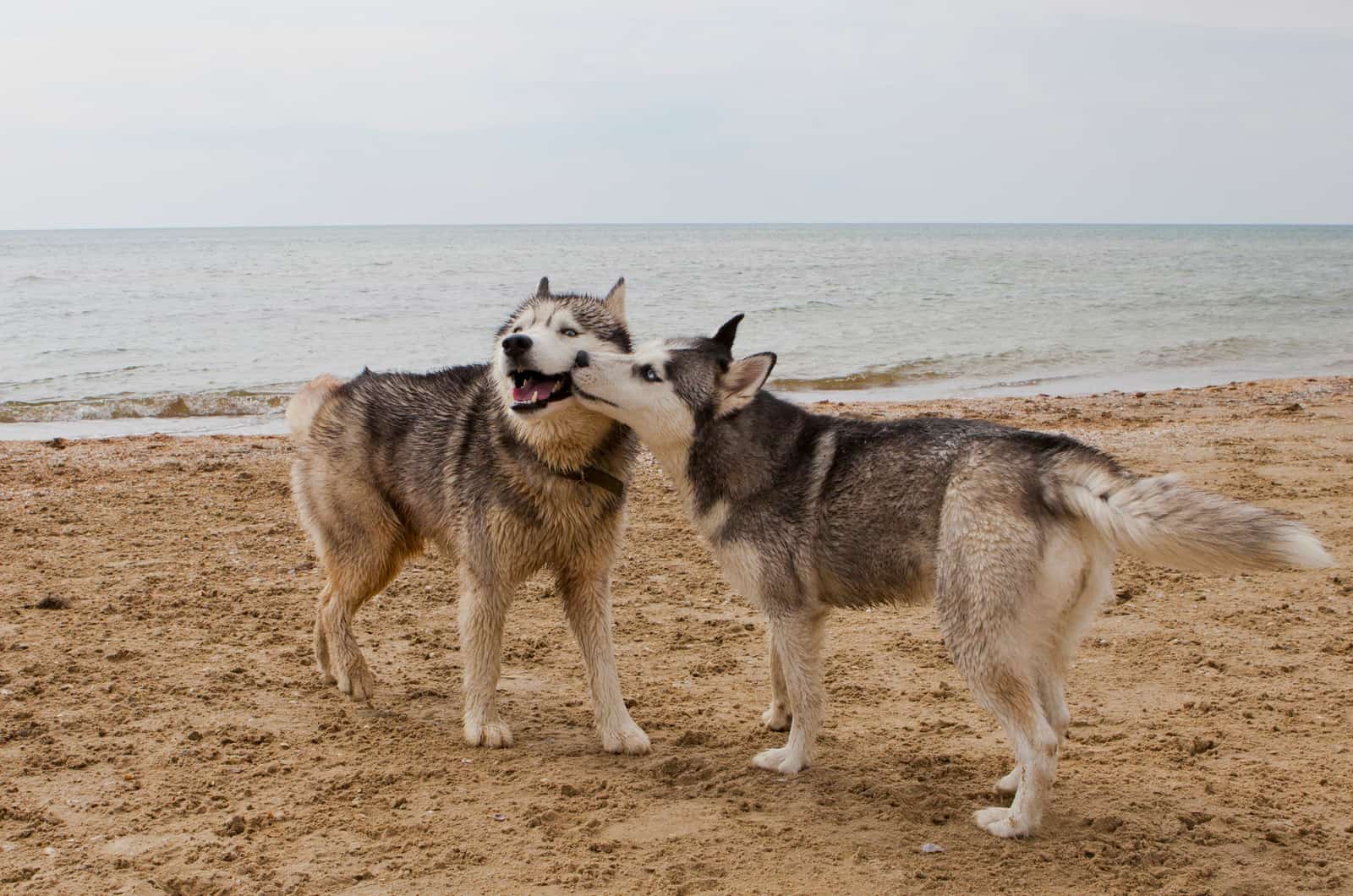
When it comes to playing and getting enough exercise, we can tell that they are some of the most important things that your Husky needs. They are active dogs and working dogs that love to be on the move.
If you want your dog to grow properly and be mentally and physically stimulated, you need to give them at least 30 to 45 minutes of exercise every day. An hour would be ideal.
Playing is important for Huskies when they are puppies. This creates an amazing bond between the dog owner and the dog, and it also gives them the ability to let go of all that energy that they build up after a sleeping session.
It is advised for you to play with your dog one-on-one every day for at least half an hour when they are puppies. This does not include the time you go for a walk or bring them to a dog park.
The Husky breed loves all types of activities. They love swimming, playing with other dogs, playing fetch, jogging, etc. You name it and you can be sure that they will be by your side participating in any activity.
Make sure that you do not over-exercise your pooch when it is a puppy. It can affect their growth platelets. They might look like they never get tired and that they can go on forever, but make sure that they take a couple of nap breaks in between playing sessions.
As they grow older you will need to provide them with much more exercise which will get more intense as well.
6. Spaying And Neutering
This might be a bit of a shock for some people. Pet owners have a decision to make when it comes to this. Some people don’t spay or neuter their dogs because they want to produce a litter later on in the dog’s life.
But other people do not want any puppies, especially unexpected ones. Spaying and neutering your dog is a responsible decision but you need to know when you can do it.
No reputable vet will do this procedure when the puppy is too young so make sure that you pick the right vet with enough knowledge and experience.
This procedure can be done when the dog turns 6 months old. If it is done earlier there can be some consequences. Dogs that went through this procedure too early can grow higher than the average height of the breed.
This might seem strange, and you might not have known this, but now that you do, make sure that your doggo goes through this procedure just at the right time.
FAQs
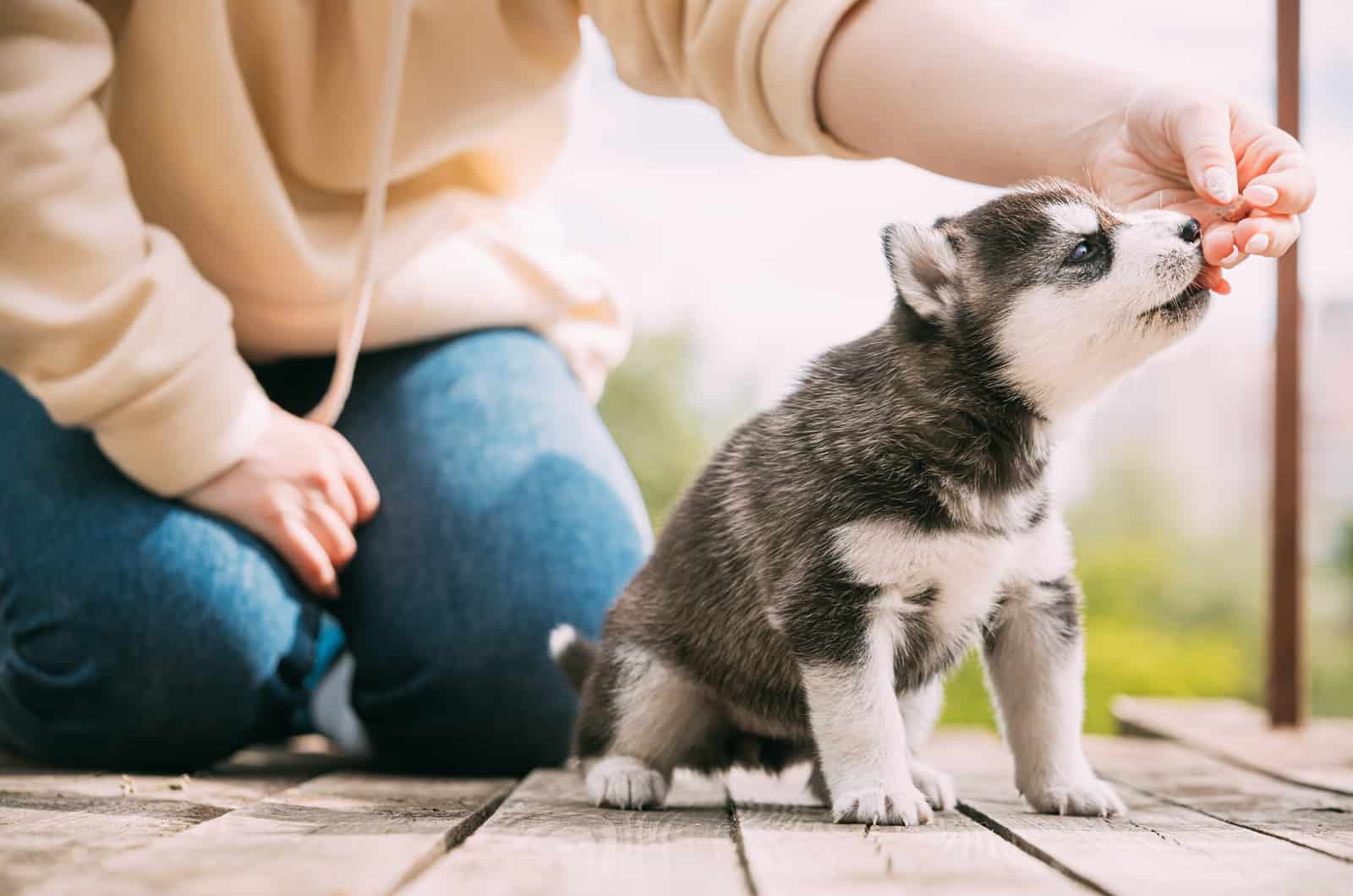
Do Huskies Go Through Growth Spurts?
A lot of bigger dogs, including Huskies, have a period in their growth process where they start growing extremely fast. With smaller dogs, this is not as noticeable as with bigger dogs.
The growth spurts are not considered to be a bad thing. It can cause some problems if they are severe, especially some joint problems, but in most cases it is just the natural way of growth for many dogs.
Pet owners will for sure be shocked by the speed of their dog growing into adult dogs so enjoy every moment when they are puppies and take a lot of pictures because it will pass in no time.
What If My Husky Is Not The Right Weight?
Well, this depends on if you think that your dog is underweight or overweight. If you think that your dog is thin, you need to re-evaluate what dog food you are giving them and if they are eating enough.
Some dogs may have smaller appetites and you need to make sure that they eat enough. You should not force the food on them but maybe try to make it more delicious by adding chicken broth for example to their food until they gain their appetite.
The dog might be eating just the right amount but are overly energized and spend a lot more time on the move. This means that you need to give them more food.
If your dog is looking a bit chubby then you are probably giving it too much food and not enough exercise.
You need to keep an eye on the amount of food and exercise that your dog is getting to know if a problem occurs, and how to fix it.
To Sum It All Up
A lot of research needs to be done before deciding on what dog to bring home. We need to say that we are more than impressed that you are doing such a detailed job when it comes to research on this breed.
One of the main factors that determine if the dog is the right match for you is the dog’s size. We hope that our Husky growth chart has helped you realize how big these pooches get.
If you end up deciding on this breed we hope that you find your future puppy as soon as possible and that you will live many happy years filled with love together.
RELATED CONTENT
– English Mastiff Growth Chart – How Big Do They Get?
– The Yorkie Growth Chart: Tips For A Healthy Growth
– Tibetan Mastiff Growth Chart Shows The Size Of Fluffy Giants













